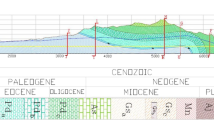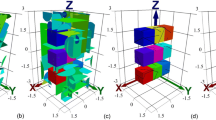Abstract
Geotechnical design input parameters, such as in situ stress field, rock mass strength parameters and deformation modulus, are never known precisely. There are always uncertainties involved in these parameters, some are intrinsic and others are due to lack of knowledge or understanding of these parameters. To quantify the effects of these uncertainties on tunnel and cavern design, it is necessary to utilize probabilistic analysis methods. In the present study, a quantitative, probabilistic approach to use the Geological Strength Index (GSI) system for rock mass characterization is presented. It employs the block volume and a joint condition factor as quantitative characterization factors to determine the GSI values. The approach is built on the linkage between descriptive geological terms and measurable field parameters such as joint spacing and joint roughness, which are random variables. Using GSI values obtained from field mapping data, and in combination with the intact rock strength properties, the probability density distributions of rock mass strength parameters and elastic moduli of the jointed rock mass can be calculated using Monte Carlo method. Furthermore, probabilistic analysis of tunnel and cavern stability based on the variable input parameters is conducted employing the point estimate method. One example is given to illustrate how to consider the variability of in situ stress and the rock mass properties in tunnel and cavern design. The method presents an approach for systematic assessment of uncertainty in rock mass characterization in rock engineering, and it can assist us to better understand how uncertainty arises and how the rock support system design decision may be affected by it.





























Similar content being viewed by others
References
Barton NR, Bandis SC (1990) Review of predictive capability of JRC-JCS model in engineering practice. In: Rock Joints, Proc. Int. Symp. on Rock Joints, Balkema, Rotterdam, pp 603–610
Barton NR, Lien R, Lunde J (1974) Engineering classification of rock masses for the design of tunnel support. Rock Mech 6(4):189–239
Barton NR, Lien R, Lunde J (1977) Estimation of support requirements for underground excavations. In: 16th US Symp. Rock Mech, pp 164–177
Bieniawski ZT (1978) Determining rock mass deformability—experience from case histories. Int J Rock Mech Min Sci Geomech Abstr 15(5):237–247
Bieniawski ZT (1984) Rock mechanics design in mining and tunneling. A.A. Balkema, Rotterdam, p 272
Brady BHG, Brown ET (2004) Rock Mechanics for Underground Mining. Springer, Berlin
Cai M (2010) Practical estimates of tensile strength and Hoek–Brown strength parameter mi of brittle rocks. Rock Mech Rock Eng 43(2):167–184
Cai M, Kaiser PK (2006) Visualization of rock mass classification systems. Geotech Geol Eng 24(4):1089–1102
Cai M, Kaiser PK, Uno H, Tasaka Y (2000) Comparative study of rock support system design practice for large-scale underground excavations. In: Proc. 4th North American Rock Mech. Symposium, Balkema, Rotterdam, pp 1027–1034
Cai M, Kaiser PK, Tasaka Y, Maejima T, Morioka H, Minami M (2004a) Generalized crack initiation and crack damage stress thresholds of brittle rock masses near underground excavations. Int J Rock Mech Min Sci 41(5):833–847
Cai M, Kaiser PK, Uno H, Tasaka Y, Minami M (2004b) Estimation of rock mass strength and deformation modulus of jointed hard rock masses using the GSI system. Int J Rock Mech Min Sci 41(1):3–19
Cai M, Kaiser PK, Tasaka Y, Minami M (2007) Determination of residual strength parameters of jointed rock masses using the GSI system. Int J Rock Mech Min Sci 44(2):247–265
Cording EJ, Hendron AJ Jr, Deere DU (1971) Rock engineering for underground caverns. In: Proc. ASCE Symp. on Underground Rock Chambers, pp 567–600
Deere DU (1968) Geological consideration. In: Stagg KG, Zienkiewicz OC (eds) Rock mechanics in engineering practice. John Wiley & Sons, New York, pp 1–20
Dershowitz WS, Einstein HH (1988) Characterizing rock joint geometry with joint system models. Rock Mech Rock Eng 21(1):21–51
Hoek E (2001) Big tunnels in bad rock, 2000 Terzaghi lecture. J Geotech Geoenviron Eng ASCE 127(9):726–740
Hoek E, Brown ET (1980) Underground excavations in rock. Institution of Mining and Metallurgy, London, p 527
Hoek E, Diederichs MS (2006) Empirical estimation of rock mass modulus. Int J Rock Mech Min Sci 43(2):203–215
Hoek E, Marinos P (2000a) Predicting tunnel squeezing problems in weak heterogeneous rock masses. Tunn Tunn 32(11):45–51
Hoek E, Marinos P (2000b) Predicting tunnel squeezing problems in weak heterogeneous rock masses. Tunn Tunn 32(12):34–36
Hoek E, Kaiser PK, Bawden WF (1995) Support of underground excavations in hard rock. A.A. Balkema, Rotterdam, p 215
Hoek E, Carranza-Torres C, Corkum B (2002) Hoek–Brown failure criterion—2002 edition. In: Proc. 5th North American Rock Mech. Symposium, Toronto, pp 267–273
Hönish K (1995) Conclusions from 100 constructed power caverns for future planning: keynote lecture. In: Eurock’ 93, Balkema, Rotterdam, pp 1013–1027
Hönish K, Nagel KH (1988) Practical use of rock mass classification for cavern & tunnel support. Int J Rock Mech Min Sci 35:4–5 (Paper No. 131)
Kaiser PK, Diederichs MS, Martin CD, Sharp J, Steiner W (2000) Underground Works in Hard Rock Tunnelling and Mining. In: Keynote lecture at GeoEng2000, Technomic Publishing Co., Melbourne, pp 841–926
Kim BH, Cai M, Kaiser PK, Yang HS (2007) Estimation of block sizes for rock masses with non-persistent joints. Rock Mech Rock Eng 40(2):169–192
Koyama T, Nanbu S, Komatsuzaki Y (1997) Large-scale cavern at a depth of 500 m. Tunn Undergr 28(1):37–45 (in Japanese)
Lichtenstein S, Newman JR (1967) Empirical scaling of common verbal phrases associated with numerical probabilities. Psychon Sci 9(10):563–564
Martin CD, Kaiser PK, Christiansson R (2003) Stress, instability and design of underground excavations. Int J Rock Mech Min Sci 40(7–8):1027–1047
Mazzoccola DF, Millar DL, Hudson JA (1997) Information, uncertainty and decision making in site investigation for rock engineering. Geotech Geol Eng 15(2):145–180
Palisade Corporation (2001) @RISK. Palisade Corporation, v.4
Palmstrøm A (1995) RMi—a rock mass characterization system for rock engineering purposes. Ph. D. thesis
Palmstrøm A, Broch E (2006) Use and misuse of rock mass classification systems with particular reference to the Q-system. Tunn Undergr Space Technol 21(6):575–593
Pells PJN (2002) Developments in the design of tunnels and caverns in the Triassic rocks of the Sydney region. Int J Rock Mech Min Sci 39(5):569–587
Priest SD, Hudson JA (1976) Discontinuity spacings in rock. Int J Rock Mech Min Sci Geomech Abstr 13(5):135–148
Priest SD, Hudson JA (1981) Estimation of discontinuity spacing and trace length using scanline surveys. Int J Rock Mech Min Sci Geomech Abstr 18(3):183–197
Rocscience Inc. (2008) Phase2. Rocscience Inc., v.7
Rosenblueth E (1981) Two-point estimates in probabilities. J Appl Math Model 5(5):329–335
Sakurai S (1981) Direct strain evaluation technique in construction of underground opening. In: 22th US Symp. Rock Mech, MIT, Cambridge, pp 278–282
Song JJ, Lee CI (2001) Estimation of joint length distribution using window sampling. Int J Rock Mech Min Sci 38(4):519–528
Tanaka H (1964) Introduction of geology for civil engineers. Sankaidou, Tokyo
Tang CA, Kaiser PK (1998) Numerical simulation of cumulative damage and seismic energy release in unstable failure of brittle rock. Part I: Fundamentals. Int J Rock Mech Min Sci Geomech Abstr 35(2):113–121
Tasaka Y, Uno H, Omori T, Kudoh K (2000) A joint and rock failure strain-softening model and its application to the excavation simulation of large-scale underground caverns. J Jpn Soc Civil Eng. III-51(652):73–90 (in Japanese)
Valley B, Kaiser PK, Duff D (2010) Consideration of uncertainty in modelling the behaviour of underground excavations. In: 5th International Seminar on Deep and High Stress Mining, Santiago, pp 423–435
Acknowledgments
The method and analysis presented in this paper were carried out to illustrate the probabilistic design approach and did not necessarily reflect the design approach adopted by Tokyo Electric Power Services Co. Ltd. (TEPSCO) and Tokyo Electric Power Company (TEPCO). The author would like to thank TEPSCO and TEPCO for previous support on the application of the GSI system for rock mass characterization.
Author information
Authors and Affiliations
Corresponding author
Rights and permissions
About this article
Cite this article
Cai, M. Rock Mass Characterization and Rock Property Variability Considerations for Tunnel and Cavern Design. Rock Mech Rock Eng 44, 379–399 (2011). https://doi.org/10.1007/s00603-011-0138-5
Received:
Accepted:
Published:
Issue Date:
DOI: https://doi.org/10.1007/s00603-011-0138-5




